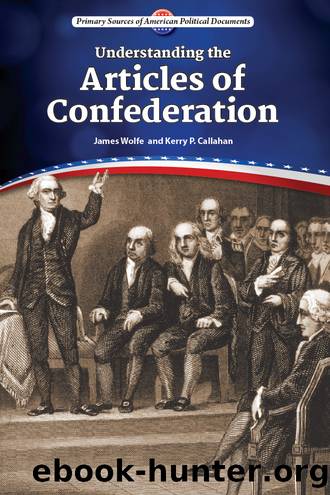Understanding the Articles of Confederation by James Wolfe

Author:James Wolfe
Language: eng
Format: epub
Publisher: Enslow Publishing, LLC
The areas west of the original colonies soon became targets for US expansion. Congress took over settlement of these lands, disregarding the people already living there.
Between 1784 and 1787, congressional policy in the West emerged in three major ordinances. In the Ordinance of 1784, Thomas Jefferson proposed granting selfâgovernment to western states as soon as settlers decided to meet and choose their own officials. When the population equaled that of the smallest existing state, the territory would achieve full statehood.
In the Land Ordinance of 1785, Congress outlined a plan of land surveys in much of the West. The Northwest was to be divided into townships six miles square along eastâwest and northâsouth lines. Each township in turn was cut into thirtyâ six lots or sections one mile square (640 acres; 2.6 km2). These 640âacre lots were to be auctioned off for no less than $1 per acre or a minimum of $640 in total. As the plots were too large or too expensive for most farmers, land speculators purchased many of the lots. They hoped to sell them for a profit.
New American Colonies
In response to land sales and settlements, Congress drafted a new and more specific plan of territorial governance in 1787. This plan modified Jeffersonâs recommendation in the 1784 ordinance for early selfâgovernment. Because Congress feared trouble from squatters who sought free land in these seemingly open territories, Congress endeavored to tighten its legal and political grip on the region. The Northwest Ordinance of 1787 required that each territory serve a period as a colony. Congress would assign a governor, a secretary, and three judges to each new territory. When the population of any territory included five thousand free male adults, it could choose an assembly. Congress would then name a territorial council of five drawn from ten names proposed by the assembly. The presiding governor would still have veto power over the council, as would Congress.
While the assignation of government powers outlined in the Northwest Ordinance resembles the relationship between the American colonists and imperial Britain, there were differences. The Ordinance allowed for statehood when any territoryâs population reached 60,000. It included a bill of rights guaranteeing religious freedom, representation in proportion to population, trial by jury, and the application of common law. Finally, Article VI of the ordinance permanently prohibited slavery in the Northwest:
There shall be neither Slavery nor involuntary Servitude in the said territory otherwise than in the punishment of crimes, whereof the party shall have been duly convicted; Provided always, That any person escaping into the same, from whom labor or service is lawfully claimed in any one of the original States, such fugitive may be lawfully reclaimed and conveyed to the person claiming his or her labor or service as aforesaid.
In addition to allowing for the capture and reclamation of fugitive slaves, the prohibition of slavery did not affect slaves already living in the territory. Neither did it stop some slaveholders from bringing slaves into the Indiana and Illinois Territories where there was strong support for slavery.
Download
This site does not store any files on its server. We only index and link to content provided by other sites. Please contact the content providers to delete copyright contents if any and email us, we'll remove relevant links or contents immediately.
Pale Blue Dot by Carl Sagan(4886)
Cracking the GRE Premium Edition with 6 Practice Tests, 2015 (Graduate School Test Preparation) by Princeton Review(4205)
Pocahontas by Joseph Bruchac(4166)
Unfiltered by Lily Collins(3946)
The Emotionary: A Dictionary of Words That Don't Exist for Feelings That Do by Eden Sher(3300)
The Daily Stoic by Holiday Ryan & Hanselman Stephen(3214)
Factfulness_Ten Reasons We're Wrong About the World_and Why Things Are Better Than You Think by Hans Rosling(3186)
The President Has Been Shot!": The Assassination of John F. Kennedy by Swanson James L(3034)
The 48 laws of power by Robert Greene & Joost Elffers(2992)
Sapiens and Homo Deus by Yuval Noah Harari(2970)
Rogue Trader by Leeson Nick(2961)
The Innovators: How a Group of Hackers, Geniuses, and Geeks Created the Digital Revolution by Walter Isaacson(2781)
The Rape Of Nanking by Iris Chang(2763)
Gettysburg by Iain C. Martin(2714)
Almost Adulting by Arden Rose(2644)
The Plant Paradox by Dr. Steven R. Gundry M.D(2530)
500 Must-Know AP Microeconomics/Macroeconomics Questions(2520)
In the Woods by Tana French(2518)
Make by Mike Westerfield(2273)
